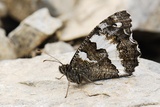Brintesia circe (Fabricius, 1775) Species
Last modified: Jan. 21, 2025, 5:13 p.m.
The first proven record of this species was in 2024 at WV.
Details
- Classification
- Family: Nymphalidae > Subfamily: Satyrinae > Tribus: Satyrini > Genus: Brintesia > Species: Brintesia circe
- Vernacular names
- Witbandzandoog (NL), Great Banded Grayling (EN), le Silène (FR), Weißer Waldportier (DE)
- Status
-
Invasive
Distribution
Egg
The eggs are white with brown spots.
Bionomics
The female lays the eggs while sitting on grasses, but this often also happens in flight. Hibernates as a young larva. Pupation takes place in a cocoon in a sheltered place or in a hole in the ground. The adults rarely rest with open wings and have a habit of resting on the trunks of trees. Its flight is more gliding than fluttering.
Flight periods
Adults are on the wing between June and September, occasionally later.
Observed on
- Substrates:
- Grasses
The larva feeds on different species of Poaceae like Bromus erectus.
Habitat
It inhabits open grasslands with scattered trees, steppes, open scrubland, and open woodland areas.

